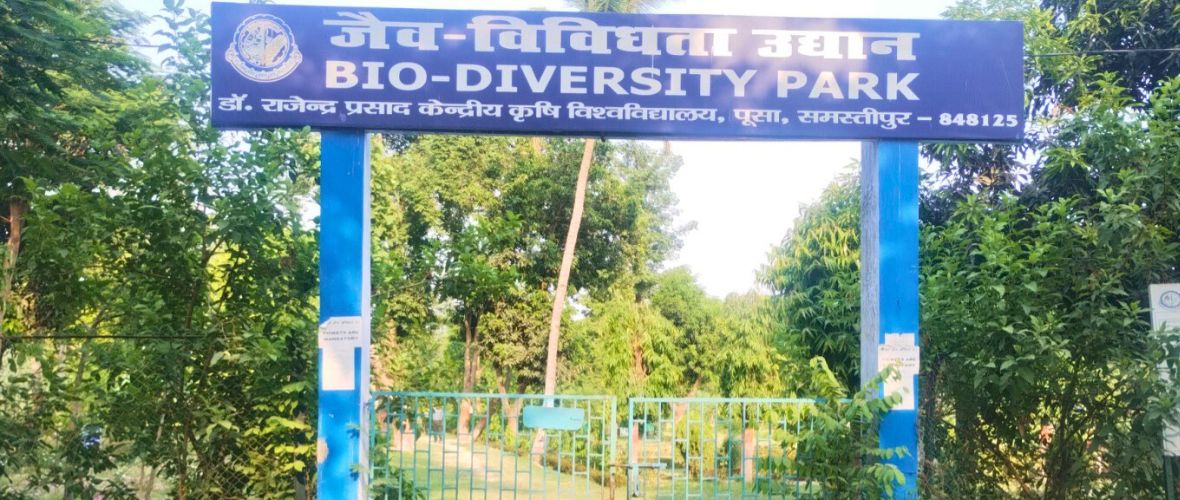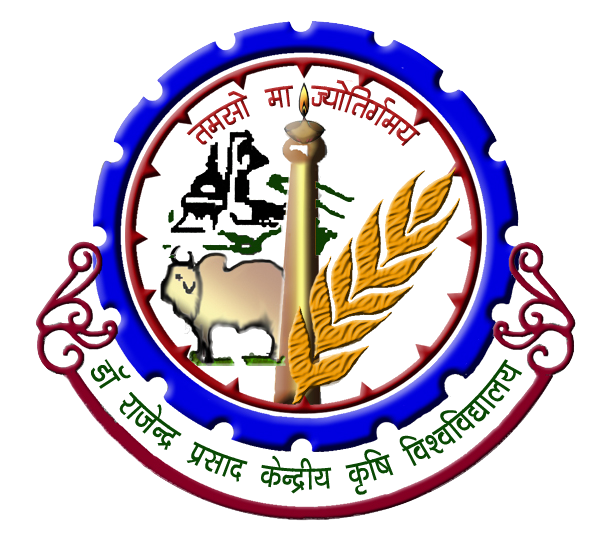Biodiversity Park, RPCAU, Pusa


BIODIVERSITY PARK, RPCAU, Pusa
The Biodiversity Park, RPCAU, Pusa has been established with primary objective to conserve the native flora and fauna of Bihar and to impart education and awareness about the need of environmental conservation. The park was inaugurated on 01st June, 2022 with a spread over 7.5 ha area within the campus of Dr. Rajendra Prasad Central Agricultural University, Pusa, Samastipur-848125, Bihar along with the creation of several components as follows:-
VIP Plantation Block
Several endangered and rare tree species were planted by various dignitaries and visitors (Adansonia digitata, Schleichera oleosa, Pterocarpus santalinus, Quercus serrata, Elaeocarpus grandiflorus, Aquilaria agallocha, etc.).
Natural Forest Tree Species Block
In the natural forest tree species block more than 80 species of trees are collected from the different stats and planted in the Biodiversity Park. The main purpose of planting of different tree species in the Biodiversity Park is given practical knowledge to the student and visitors. Various species are very unique and rare in particular region.
Cane Block
Several plants of cane (Rattan) are planted to diversify the plant community in the park. The rattan stem is solid, strong and uniform and highly flexible. The canes are used especially for furniture frames, or split, peeled or cored for matting and basketry.
Un-conventional Fruits Block
Various fruit tree uncommon to the region are being planted including, Apple, Pear, Star fruit Apricot, Avocado, etc.
Navgraha Van
In the Biodiversity Park Navgraha Van is established to increase the importance of Navgraha van between the society. Navgraha Van plants are planted in particular place and direction and gives protection from the negative forces that are mention in our horoscopes. They bring prosperity, good health and wealth, protection, showing right direction and attracts with good intentions only. Indian astrology claims a definite correlation between plants and Navagrahas – the 8 planets and the Sun at the centre. These planets are supposed to influence different organs in the body either in positive or negative manner and may result in diseases due to evil effects. Different plants have been prescribed for usage to overcome the ailments. Such plants are thus associated with the planets and are believed to have medicinal properties for treating the diseases. A Navgraha Van would thus typically include plants associated with each of the navgrahas, viz. Budh Achyranthes aspera (Chichida), Shukra Ficus glomerata (Gular), Chandra Butea monosperma (Palas), Guru Ficus religiosa (Pipal), Surya Calotropis procera (Aak), Mangal Acacia catechu (Khair), Ketu Imperata Cylindrica (Dabhi), Shani Prosopis Cenneraria (Shami), Rahu Cynodon dactylon (Doob).
Nakshatra Van
In the Biodiversity Park Nakshatra Van is established and planted 27 different plants as per the Nakshatra. Each plant represents the each Nakshatra. Constellations are groups of stars which appear to be fixed in the sky. The Hindu Panchanga assigns a separate tree for each of the 27 constellations (Nakshatras) through which the Sun passes. It is believed that celestial bodies like the Sun and the Moon exert different influences on human beings when they are transiting through these 27 constellations. It is also believed that such effects can be moderated or enhanced by planting and worshipping trees assigned to each constellation. This collection of trees planted in the correct order constitutes a Nakshatra Van.
Rashi Van
In The Biodiversity park rashi van established and planted 12 plants one plant for one rashi. The 27 constellations are again dividing into 12 Zodiac signs groups. The Zodiacs play a important role in the lives of human beings. Indian Astrology has assigned specific trees for specific zodiac signs.
Saptharishi Van
In the Indian mythology, according to Sapta Brahamana, the seven stars in the constellation Ursa Major, are associated with the seven major Indian saints and the constellation is known as Saptarshi (the seven rishis) – Kasyapa, Atri Bharadwaja, Visswamitra, Gouthami, Jamadagni and Vasistha. The trees identified with these seven saints constitute the Saptarshi Van. These are Ocimum tenuiflorum (Tulsi), Sesbania grandiflora (Agust tree), Areca catechu (Supari), Aegle marmelo s(Bel), Datura metel (Dhatura), Jasminum angustifolium (Chandni), Prosopis cineraria (Shami) respectively.
Panch Pallav Van
Panch Pallava (Five Leaves), it is used ritually for marriages and in different Poojas like Satyanarayan, Kothom, Pratishtha, Satchandi, Shastrachandi, Gayatri Purascharana, Vastushanti, Durga Pooja, Mahalaxmi, Bhoomi Pujan, Moolshanti, Rudrabhishek, Upnayan Sanskar, etc. These five leaves used are Mango, Paakar, Gular, Peepal and Banyan.
Panchvati Van
A group of five holy trees, namely, Vad (Ficus benghalensis), Pipal (Ficus religiosa), Bilva or Billi (Aegle marmelos), Amla (Emblica officinalis) and Ashok (Saraca indica) is called Panchvati. In the pacnhvati five trees are planted in five five directions that why it’s known as “Panchvati”. The importance of Panchavati is described in the Skanda Purana. Its structure is used for Ayurveda, psychology, industrial architecture, protection, and environmental protection. These five trees have great medicinal properties, religious importance, and importance for the environment. Planting of different trees in five directions is discussed in Skanda Purana. Banyan tree gives shade, Pipal produces oxygen, Bilva is offered to lord Shiva, Amla has significant medicinal properties, it is good source of vitamin C and Ashok drives away sorrows. It is, therefore, believed that Panchvati is good for overall well-being of the mankind.
Trithankkar Van
The 24 Tirthankars of Jainism were enlightened with eternal knowledge under various trees. These trees are known as “Kevali Vriksha”. It is believed that planting of these trees brings blessings of the Tirthankaras. The design of this Van is based on the ‘Kalpa
Vriksha” yantra, where the trees associated with the Tirthankars are planted.
Shree-Parni Van
In Hindu mythology, the goddess Laxmi resides in Shriparni (Gmelina arborea) – a common tree found throughout India. It is believed that this tree creates a divine environment. Therefore, Laxmi resides in such a place with Lord Vishnu bringing in peace, happiness and prosperity for the worshippers and the people who raise such trees.






















 Users Today : 894
Users Today : 894 Total Users : 4433544
Total Users : 4433544